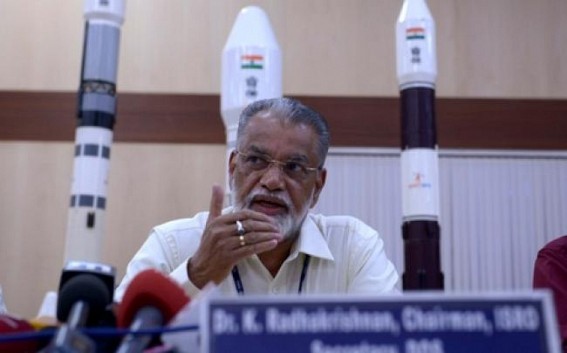By Fakir Balaji

PHOTO : ISRO
Bangalore, Nov 4 (IANS) India will be the first Asian country and the fourth entity in the world to leap into interplanetary space Tuesday with an exploratory mission to Mars, about 400 million km from planet Earth.
"So far, only Russia, the US and the European Space Agency (ESA) have undertaken such missions to Mars. India will be the fourth and first in Asia," a top space agency official told IANS ahead of the Mars Orbiter Mission (MOM) launch from Sriharikota spaceport, about 80km northeast of Chennai.
As the fourth planet from the Sun, Mars is the second smallest celestial body in the solar system. Named after the Roman god of war, it is also known as the Red Planet due to the presence of iron oxide in abundance, giving it a reddish appearance.
"Mars sways human imagination like no other planet in the solar system because its conditions are believed to be hospitable. It is similar to earth in many ways," state-run Indian Space Research Organisation (ISRO) chairman K. Radhakrishnan said in an interview here.
Though both planets have an equal period of revolution around their axis, Mars takes 24 hours and 37 minutes to complete a revolution. The Earth takes around 365 days to orbit the Sun and Mars takes 687 days to do so.
"Mars Orbiter Mission (MOM) is a major step forward in our space programme and a turning point for us, as India will foray into the vast interplanetary space for the first time with an indigenous spacecraft to demonstrate our technological capabilities," Radhakrishnan asserted.
Admitting that the Rs.450-crore ($72 billion) mission was a complex and challenging task in view of the sheer distance, the journey's duration (over nine months) and the five experiments to be conducted in the Martian orbit, Radhakrishnan said his scientists had only 15 months to prepare for the launch in November 2013, as the next opportunity for such a mission was 780 days later in January 2016.
"Moreover, of the 51 Mars missions so far, only 21 could be successful, partially due to launch failure, propulsion failure and lack of understanding of the Red Planet's gravity. Nine missions could not orbit," he recalled.
Though space science has been a part of its mission since the days of sounding rockets from Thumba in Kerala during the 1960s, ISRO forayed into frontier science with its maiden moon mission Chandrayaan-1 in 2008, which led to the discovery of water for the first time on the lunar planet.
"As our space programmes has been application-centric and people-centric over the past five decades, development of indigenous capabilities to build satellites and launch vehicles (rockets) took precedence over space exploration, which is complex and challenging," the chairman said.
Explaining the challenges of an interplanetary mission, Radhakrishnan said the mission's Orbiter would pass through three phases - geo-centric, helio-centric and Martian.
"When we inject the spacecraft (Orbiter) from the earth's orbit Dec 1 into outer space in a trajectory, we have to precisely compute 280 days in advance the position it would achieve near Mars, which will be 500 km above its surface at that time," Radhakrishanan observed.
A 350-tonne rocket, an extended version of the space agency's workhorse - the polar satellite launch vehicle (PSLV-C25), will put the 1,340 kg spacecraft into an elliptic parking orbit of the earth at 3.38 p.m., which will be 44 minutes after its lift-off at 2.38 p.m. (IST) from the spaceport off the Bay of Bengal.
Though the spacecraft will rotate around earth from Nov 5-30, at a perigee (nearest to equator) of 250 km, its apogee (farthest from equator) will be raised Nov 16 to 192,000 km from 23,500 km by firing its motors from ISRO's telemetry, tracking and command network (Istrac) in Bangalore.
"At 00.42 a.m. IST Dec 1, we will provide Orbiter a velocity by firing the motor for cruising towards Mars. After a nine-month voyage, when it nears the red planet, we will reduce the velocity Sept 24, 2014 by again firing the motor in reverse direction to precisely capture the Martian orbit. Otherwise, we will lose it," Radhakrishnan noted.
The spacecraft's speed, which will be 9.8 km per second after launch, during five orbit-raising maneouvres and trans-orbit injection, will be given an additional velocity of 1.55 km per second for its over nine-month journey and reduced to 1.11 km per second when it reaches Mars Sept 24 to orbit around it at that speed for over six months.
"During the 300-day cruise, there will be mid-course corrections in the Orbiter's speed, which is calculated in accordance with the natural orbit of earth and Mars around sun," Radhakrishnan said.
Once the Orbiter is placed in the Martian orbit, its five indigenous instruments onboard could commence their scientific observations.
"As distance to Mars is far too long (440 million km) and communication delay between the Orbiter and ground stations will be 4-20 minutes, we have built sufficient autonomy in it to manage itself during the interim and till its signals reach the ground and till ground controllers' commands reach it," he added.
The mission has also built-in mechanism for contingencies and redundancies have been built into the systems and the onboard autonomy to switch over from primary to standby system.
- PM Modi's spectacular performance in India's By-Polls
- BJP-RSS want to destroy India's democratic structure: Rahul
- Kuldeep will be India's No.1 spinner going forward: Harbhajan Singh
- 2002 Gujarat riots: Despite request to CM Modi, Army lost a crucial day waiting for vehicles : Retd. Lt. General
- Progress of nation more important than debates: Kamal Haasan



